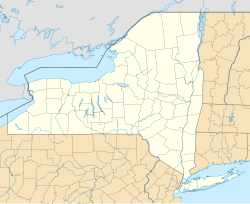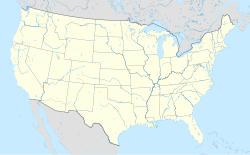St. George's Episcopal Church (Manhattan)
St. George's Episcopal Church | |
 | |
| Location | 209 East 16th Street, Manhattan, New York City, New York |
|---|---|
| Coordinates | 40°44′04″N 73°59′06″W / 40.734397°N 73.984964°W |
| Built | 1846–1856[2] |
| Architect | exterior: Otto Blesch interior: Leopold Eidlitz[3] |
| Architectural style | Romanesque Revival |
| NRHP reference No. | 76001249[1] |
| NYSRHP No. | 06101.002718[4] |
| Significant dates | |
| Added to NRHP | December 8, 1976 |
| Designated NHL | December 8, 1976[5] |
| Designated NYSRHP | February 28, 1980[4] |
| Designated NYCL | June 20, 1967 |
St. George's Episcopal Church is a historic church located at 209 East 16th Street at Rutherford Place, on Stuyvesant Square in Manhattan, New York City. Called "one of the first and most significant examples of Early Romanesque Revival church architecture in America",[6] the church exterior was designed by Charles Otto Blesch and the interior by Leopold Eidlitz. It is one of the two sanctuaries of the Calvary-St. George's Parish.
History
[edit]

The original St. George's was a chapel built in 1752 by Trinity Church on Chapel Street (now Beekman Street) in Lower Manhattan, for the convenience of its congregants who lived on the east side of the city. That building had a columned portico, arched windows and a hexagonal steeple.[7][8] In 1811 the congregation became independent,[9][10] and in 1846–1856 they built a new church uptown, on very fashionable Stuyvesant Square.
The architects of the new church were Charles Otto Blesch and Leopold Eidlitz. The exterior design, attributed to Blesch, was influenced by the Rundbogenstil (round-arch style) Ludwigskirche in Munich and the plain hall churches of Germany. Eidlitz designed the interior spaces.[6] He also designed the rectory—also known as the Henry Hill Pierce House—which was built in the early 1850s.[2] The spires on each tower of the church were completed almost a decade after the remainder of the building.
The church was gutted by fire in 1865,[9][11] and was rebuilt within the next two years[9] under the supervision of Eidlitz.[2][6] The pastor of St. George's at the time of the reconstruction was Stephen H. Tyng, who was a leader in the evangelical wing of the Episcopal Church, and considered to be one of the most notable preachers of the time.[6] Under his instructions, the interior of the rebuilt church reflected his views: the altar, for instance, was a plain table.[9]
In 1889, more than twenty years after the church had been rebuilt, the spires on the two towers were removed.[3]
For decades while J.P. Morgan was senior warden and the church's most influential parishioner,[12] the church was colloquially referred to as "Morgan's Church".[9] By 1880, the Episcopal church sat in the middle of a neighborhood filled with immigrants, who were largely Catholic and Jewish; its parishioners had moved elsewhere under pressure of new populations.
Through Morgan's initiative, the church brought in the Rev. William Stephen Rainsford[13] as the new rector in 1883. Rainsford, who had experience with urban ministries, felt that "the whole aspect of the modern Protestant churches, in our large cities at least, is repellent to the poor man."[11] His plan, of which Morgan approved, was to downplay doctrinal matters, abolish pew rentals, and offer secular social services programs aimed at helping the poor: an industrial school, sewing classes, soup kitchens, health programs, boys' and girls' clubs, and other educational and recreational initiatives. Morgan agreed to finance any deficits from these programs. Within seven years, the new direction of the church, combined with Rainsford's socially oriented preaching, had revitalized the congregation and made the church a leader in the institutional church movement.[11][12][14]
Besides J. P. Morgan, another notable congregant of the church was Harry Thacker Burleigh, the spiritual singer and classical composer. He performed in the church choir for 50 years.[15]
In 1976, the parish merged with two others—Calvary Church, which was founded in 1832 and moved to the Gramercy Park area in 1842, and the Church of the Holy Communion, built on Sixth Avenue in 1844—to form the Calvary-St George's Parish.[15] Calvary Church is still operating, on Park Avenue South at 21st Street, but the Church of the Holy Communion was deconsecrated and sold to pay down the debts of the new combined parish. It was adapted as the Limelight disco. It then operated as a marketplace and from 2017 as a gym.
Historic designations
[edit]

The church is part of a complex of buildings which includes Eidlitz' rectory, and the St. George Memorial House at 207 East 16th Street, designed by his son, Cyrus L. W. Eidlitz, and built in 1886 as a gift from J. P. Morgan,[2][6] as well as the neo-Romanesque St. George's Chapel by Matthew Lansing Emery and Henry George Emery, built in 1911–1912[2][6] All the buildings are part of the Stuyvesant Square Historic District, and the church itself is a New York City landmark, designated in 1967, and was named a National Historic Landmark in 1976.[5][17][18] The church's facade was reportedly restored in 1980;[6] however the primary preservation of facade stone was undertaken in 1985.
Rectors
[edit]- The Rev. James Milnor, D.D. (1773–1845), was rector at St. George's Chapel from 1816 until his death on April 8, 1845, in New York City.
- The Rev. William S. Rainsford (October 30, 1850 – December 17, 1933) was the rector from 1883 to 1906.[19][20]
See also
[edit]- The St. George
- Calvary-St George's Parish
- Saint George: Devotions, traditions and prayers
- Calvary Church (Manhattan)
- Church of the Holy Communion and Buildings, a deconsecrated church
References
[edit]Notes
- ^ "National Register Information System". National Register of Historic Places. National Park Service. July 9, 2010.
- ^ a b c d e White, Norval & Willensky, Elliot (2000). AIA Guide to New York City (4th ed.). New York: Three Rivers Press. ISBN 978-0-8129-3107-5., p.209
- ^ a b nyc-architecture.com
- ^ a b "Cultural Resource Information System (CRIS)". New York State Office of Parks, Recreation and Historic Preservation. November 7, 2014. Retrieved July 20, 2023.
- ^ a b "St. George's Episcopal Church (New York)". National Historic Landmark summary listing. National Park Service. September 18, 2007. Archived from the original on June 6, 2011.
- ^ a b c d e f g New York City Landmarks Preservation Commission; Dolkart, Andrew S.; Postal, Matthew A. (2009). Postal, Matthew A. (ed.). Guide to New York City Landmarks (4th ed.). New York: John Wiley & Sons. ISBN 978-0-470-28963-1., pp.85–86
- ^ Burrows & Wallace 1999, p. 177.
- ^ Anstice 1911, pp. 22–193.
- ^ a b c d e Federal Writers' Project (1939). New York City Guide. New York: Random House. ISBN 978-1-60354-055-1. (Reprinted by Scholarly Press, 1976; often referred to as WPA Guide to New York City.), p.190
- ^ Greenleaf, Jonathan (1846). A History of the Churches, of All Denominations, in the City of New York, from the First Settlement to the Year 1846. New York: E. French. pp. 63–65.
- ^ a b c Burrows & Wallace 1999, p. 1171.
- ^ a b Mullin, Robert Bruce. "St. George's Episcopal Church" in Jackson, Kenneth T., ed. (1995). The Encyclopedia of New York City. New Haven: Yale University Press. ISBN 0300055366., p.1034
- ^ Utzinger 2006, p. 36.
- ^ Utzinger 2006, p. 34.
- ^ a b "Official History" on the parish website
- ^ "Montgomerie's Ward, New York City, 1755". Map of area; available on Wikimedia Commons.
- ^ Gomez-Graves, Lynne (n.d.). "St. George's Episcopal Church (Harry T. Burleigh)". National Register of Historic Places Inventory-Nomination. National Park Service.
- ^ "St. George's Episcopal Church (Harry T. Burleigh)--Accompanying 2 photos, exterior". National Register of Historic Places Inventory-Nomination. National Park Service. n.d.
- ^ Anstice 1911, pp. 292–369.
- ^ "Dr. W.S. Rainsford Dies in 84th Year". The New York Times. December 18, 1933. p. 19.
Bibliography
- Anstice, Henry (1911). History of St. George's Church in the City of New York 1752–1811–1911. New York: Harper & Brothers.
- Burrows, Edwin G. and Wallace, Mike (1999). Gotham: A History of New York City to 1898. New York: Oxford University Press. ISBN 0-195-11634-8.
- Curran, Kathleen (2003). The Romanesque Revival: Religion, Politics, and Transnational Trade. University Park, PA: Penn State University Press.
- Holliday, Kathryn (2008). Leopold Eidlitz: Architecture and Idealism in the Gilded Age. New York: W.W. Norton.
- Utzinger, J. Michael (2006). Yet Saints Their Watch Are Keeping. Macon, Georgia: Mercer University Press.
External links
[edit]- Churches completed in 1843
- Churches in Manhattan
- 19th-century Episcopal church buildings
- National Historic Landmarks in Manhattan
- Episcopal church buildings in New York City
- Properties of religious function on the National Register of Historic Places in Manhattan
- Leopold Eidlitz church buildings
- New York City Designated Landmarks in Manhattan
- Religious organizations established in 1752
- Gramercy Park
- 1752 establishments in the Province of New York
- New York State Register of Historic Places in New York County




